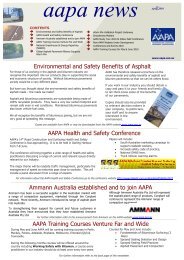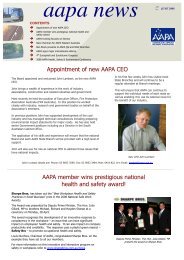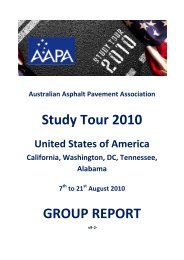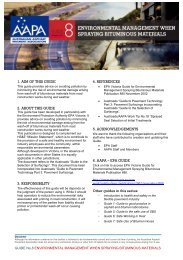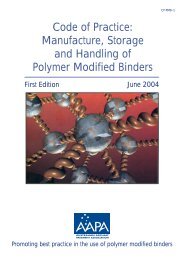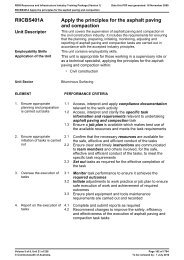Asphalt Review - Volume 32 Number 3 (Jun / Juy 12) - Australian ...
Asphalt Review - Volume 32 Number 3 (Jun / Juy 12) - Australian ...
Asphalt Review - Volume 32 Number 3 (Jun / Juy 12) - Australian ...
Create successful ePaper yourself
Turn your PDF publications into a flip-book with our unique Google optimized e-Paper software.
ASPHALT REVIEWFigure 3. In-Place Material Propertiesto the RAP sections. Conversely, at 50°F andbelow, there were no statistical differencesbetween any of the sections.Through the end of the 2009-11 researchcycle, no cracking had been observed on anyof the sections. Therefore, at this point, theycould be judged to have equivalent crackingperformance based on field data. However,some estimates regarding future crackingperformance can be made using the fieldmeasuredstrain from Figure 2 combined withlaboratory beam fatigue testing conducted oneach base mixture.The reason the RAP sections have goodcracking performance on the Test Track can beexplained by the laboratory fatigue testing. Thehigher-stiffness RAP mixtures resulted in lowermeasured strains in the field compared to theconventional hot mix. Fatigue testing of higherstiffnessRAP mixtures at these lower strain levelsresults in a longer fatigue life in the laboratory.Deflection Testing andMaterial PropertiesDuring the test cycle, each section wassubjected to deflection testing using a fallingweightdeflectometer (FWD) several times40 ROADS JUNE/JULY 20<strong>12</strong>per month. These deflections were usedto find the in-place stiffness properties ofeach section using back-calculation. Figure3 summarizes the in-place stiffness versustemperature. The fitted curves on each set ofpoints shows, as expected, that the controlsection was softest, followed by the RAP-WMAsection, with the RAP-HMA section the stiffest.Though there is scatter within the data, whichmight lead one to believe that they are similar,they are actually statistically significant, withthe greater differences noted at the highesttemperatures. For example, at 110°F, the RAP-WMA section was approximately 26% stifferthan the control while the RAP-HMA sectionwas nearly 41% stiffer than the control. Theincreased stiffness contributed to the lowermeasured strain levels shown in Figure 2.PerformanceEach section was inspected on a weeklybasis over the two-year traffic cycle. At theconclusion of traffic in September 2011, nocracking had been observed on any of thesections. Minor amounts of rutting wereobserved, with the control section havingapproximately 5 mm while both RAP sectionswere around 2.5 mm. The slightly betterrutting performance could be attributed tothe increased stiffness of the materials asnoted above.Moving ForwardAfter the first 10 million standard loadapplications, the 50% RAP sections haveproven themselves to reduce strain levelsthrough increased stiffness with the sametotal thickness as the control section. Thesedifferences are more pronounced at highertemperatures. Since no cracking and a veryminor amount of rutting have been observedto this point, the plan is to continue traffic onthese sections into the 20<strong>12</strong> Test Track researchcycle to more fully evaluate the sections.However, at this point, one cannot overlookthe sustainability benefits in the short termby utilizing 50% RAP combined with WMA toachieve equivalent or better performance thanthrough conventional materials. ■*David H. Timm, Ph.D., is Brasfield & Gorrie Professorof Civil Engineering, Auburn University. Adriana Vargas-Nordcbeck is a doctoral candidate in Civil Engineering,Auburn University. J. Richard Willis, Ph.D., is AssistantResearch Professor, National Center for <strong>Asphalt</strong>Technology, Auburn University.




